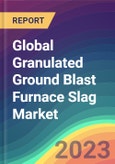The global Granulated Ground Blast Furnace Slag (GGBFS) market has reached around 377 million tonnes in 2021 and is expected to grow at a CAGR of 3.20% during the forecast period until 2035.The Global Granulated Ground Blast Furnace Slag (Ggbfs) Market Has Reached Around 377 Million Tonnes in 2021 and is Expected to Grow at a CAGR of 3.20% During the Forecast Period Until 2035
Granulated Ground Blast Furnace Slag (GGBFS) is a by-product of the iron blast furnace process. In this process, iron ore, limestone, and coke are reacted to a temperature of approximately 1500°C in the furnace. GGBFS displays unique properties like it is highly resistant to chemicals, salty water, freezing and thawing. When GGBFS is added to concrete, the property of concrete is improved. Granulated Ground Blast Furnace Slag (GGBFS) improves the compressive strength, longer durability, and utility of concrete.
Based on type, Granulated Ground Blast Furnace Slag (GGBFS) market has two types available which are, Alkalinity Blast Furnace Slag and Acidic Blast Furnace Slag. Wherein the major portion is held by Alkalinity Blast Furnace Slag with around 73% of the global market in 2021. The slag is helpful for longevity of concrete which promotes its strength and utility. Also, Granulated Ground Blast Furnace Slag (GGBFS) helps as an insulating material.
The primary market drivers of GGBFS are the Portland Cement & Concrete Industry. In 2021, this industry held a market share of approximately 69% of global GGBFS market. Granulated Ground Blast Furnace Slag when crushed or milled to very tiny cement-sized particles, displays geopolymeric qualities that make it a viable additive for Portland cement. The Granulated Ground Blast Furnace Slag (GGBFS) consumption is anticipated reach around 585 million tonnes by 2035.
The dominating region that demands the most significant volume in Asia Pacific Region. Owing to rapid industrialization and new construction projects, the demand of cement and concrete will rise in developing nations like India, which is anticipated to result in expansion of GGBFS market. Currently, China is the highest producer of Granulated Ground Blast Furnace Slag (GGBFS). China Baowu Steel Group Corp. holds the highest capacity and operates exclusively in Jiangsu and Wuhan City.
Based on the end-user industry, the Granulated Ground Blast Furnace Slag (GGBFS) market has various uses in construction industry like Portland Cement & Concrete, Bricks & Blocks, and Others. The slag is deployed for land filling and other commercial purposes as well. However, Portland Cement & Concrete is the biggest end-user market of Granulated Ground Blast Furnace Slag, which is expected to increase the GGBFS demand in the upcoming years.
Significant companies for Global Granulated Ground Blast Furnace Slag (GGBFS) market are China Baowu Steel Group Corp., Ltd, Nippon Steel Corporation, ArcelorMittal S.A., JFE Steel Corporation, Maanshan Iron & Steel Company Limited, Changcheng Special Steels Co Ltd, Baosteel, Hunan Valin Xiangtan Iron and Steel Co., Ltd., Zenith Steel Group Co. Ltd., Gansu Jiu Steel Group Hongxing Iron and Steel Co ltd., TATA Steel and Others.
Years considered for this report:
- Historical Period: 2015- 2021
- Base Year: 2021
- Estimated Year: 2022
- Forecast Period: 2023-2035
The objective of the Study:
- To assess the demand-supply scenario of Granulated Ground Blast Furnace Slag (GGBFS), which covers the production, demand, and supply of Granulated Ground Blast Furnace Slag (GGBFS) around the globe.
- To analyze and forecast the market size of Granulated Ground Blast Furnace Slag (GGBFS).
- To classify and forecast the Global Granulated Ground Blast Furnace Slag (GGBFS) market based on end-use and regional distribution.
- To examine global competitive developments such as new capacity expansions, mergers & acquisitions, etc., of the Granulated Ground Blast Furnace Slag (GGBFS) market.
The publisher calculated Granulated Ground Blast Furnace Slag (GGBFS) demand around the globe by analyzing the historical data and demand forecast, which was carried out considering the production of raw material to produce Granulated Ground Blast Furnace Slag (GGBFS). The publisher sourced these values from industry experts and company representatives and externally validated them by analyzing the historical sales data of respective manufacturers to arrive at the overall market size. Various secondary sources, such as company websites, association reports, annual reports, etc., were also studied by the publisher.
Key Target Audience:
- Granulated Ground Blast Furnace Slag (GGBFS) manufacturers and other stakeholders
- Organizations, forums and alliances related to Granulated Ground Blast Furnace Slag (GGBFS) distribution
- Government bodies such as regulating authorities and policy makers
- Market research organizations and consulting companies
Report Scope:
In this report, Global Granulated Ground Blast Furnace Slag (GGBFS) market segments into following categories, in addition to the industry trends which have also been detailed below:- Market by End-use: Portland Cement & Concrete, Bricks & Blocks, and Others
- Market, by Sales Channel: Direct Sale and Indirect Sale
- Market, by Region: North America, Europe, Asia Pacific, Middle East and Africa, and South America.








